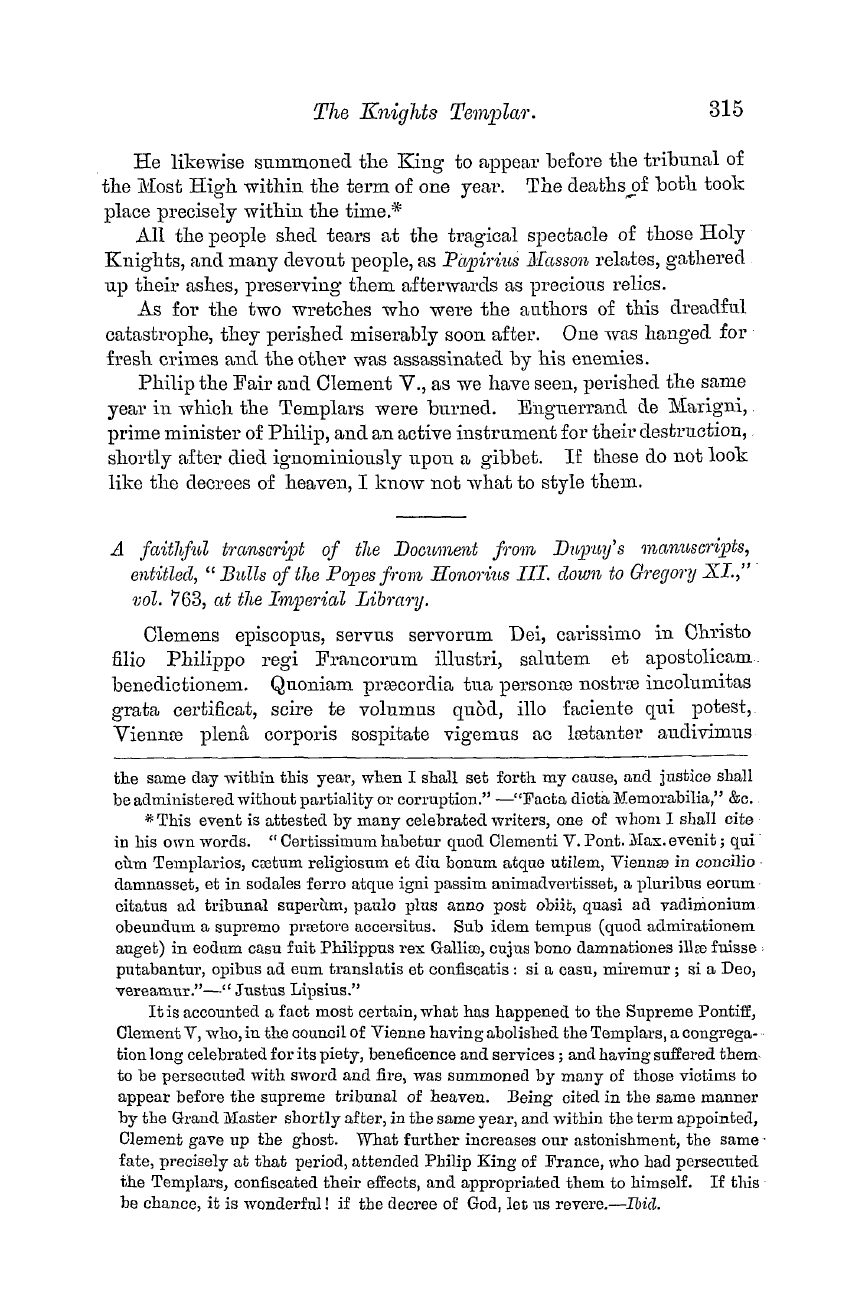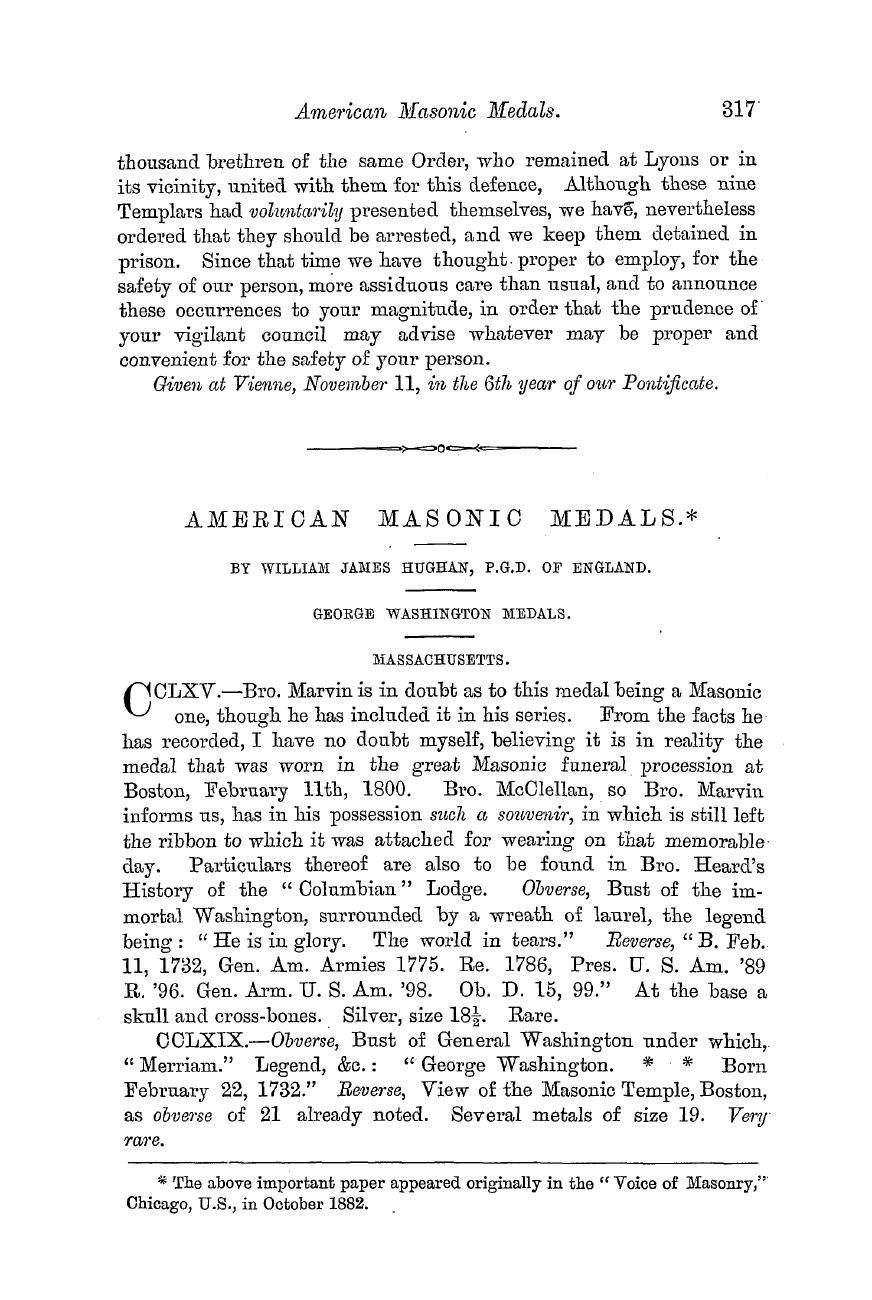Note: This text has been automatically extracted via Optical Character Recognition (OCR) software.
The Legend Of The Introduction Of Masons Into England.
aid . His dwelling-place was divided into two parts : * an oratory ( oratorium ) namely , and another dwelling ( habitacjilum ) suitable for common uses . He constructed the walls of both , by digging round , or by cutting out much of the natural earth , inside and
outwardly ; but the roof was formed of rough beams and thatched with straw . Moreover , there was a larger house ( domus ) at the landingplace of the island , in which the monks , when they came to see him , might be received and rest ; and not far from this there was a fountain of water adapted for the supply of then- wants . "
" The above abode and out-houses" ( mansione ac domibus ) it is stated f were constructed " with the aid of the brethren ; " and Mr . Stevenson informs us in a note that like the cleft in the rock , " all the places mentioned by Bede are yet clearly distinguishable on this
most interesting island . " In the year 699 , after the death of St . Cuthbert J , on Aediluuald , another monk , retiring to the same spot , " he found , however , that the walls of the oratory there , which had been roughly and carelessly put together , had fallen into great disxejpair through age , and that the planks , from being separated one
from the other , gave ready access to the stormy winds . But as the venerable man looked more on the beauty of the heavenly edifice than to that of the earthly , he stopped up the chinks with straw , or clay , or whatever other material he could find , lest he should be hindered from instant prayer by the daily inclemency of the rains or the winds .
When , therefoz-e , Aediluuald discovered the place to be in such a condition , he asked his brethren who came to see him to bring him a calf's hide , which he nailed up to stop the violence of the storms , in that corner in which he and his predecessor Cudberct were so often wont to stand or kneel in prayer . "
In something over twelve years the oratory was restored " thoroughly from its foundations" by Eadfrid , bishop of Lindisfarne , but it is not recorded in what manner . " When he [ Cuthbert ] § was disposed to build a little hut for himself in his monastery , suited to his daily necessities , he selected a spot
by the sea-side , where the dashing of the frequent waves had hollowed out the rock into a deep and narrow cleft , about the width of twelve feet , across which a foundation is required to be thrown . " He requests the monks who visit him to bring him a piece of timber "to form a base of the little building . " They forget the request , and on the prayer of St . Cuthbert the sea washed up to the place required a suitable beam of wood .
Note: This text has been automatically extracted via Optical Character Recognition (OCR) software.
The Legend Of The Introduction Of Masons Into England.
aid . His dwelling-place was divided into two parts : * an oratory ( oratorium ) namely , and another dwelling ( habitacjilum ) suitable for common uses . He constructed the walls of both , by digging round , or by cutting out much of the natural earth , inside and
outwardly ; but the roof was formed of rough beams and thatched with straw . Moreover , there was a larger house ( domus ) at the landingplace of the island , in which the monks , when they came to see him , might be received and rest ; and not far from this there was a fountain of water adapted for the supply of then- wants . "
" The above abode and out-houses" ( mansione ac domibus ) it is stated f were constructed " with the aid of the brethren ; " and Mr . Stevenson informs us in a note that like the cleft in the rock , " all the places mentioned by Bede are yet clearly distinguishable on this
most interesting island . " In the year 699 , after the death of St . Cuthbert J , on Aediluuald , another monk , retiring to the same spot , " he found , however , that the walls of the oratory there , which had been roughly and carelessly put together , had fallen into great disxejpair through age , and that the planks , from being separated one
from the other , gave ready access to the stormy winds . But as the venerable man looked more on the beauty of the heavenly edifice than to that of the earthly , he stopped up the chinks with straw , or clay , or whatever other material he could find , lest he should be hindered from instant prayer by the daily inclemency of the rains or the winds .
When , therefoz-e , Aediluuald discovered the place to be in such a condition , he asked his brethren who came to see him to bring him a calf's hide , which he nailed up to stop the violence of the storms , in that corner in which he and his predecessor Cudberct were so often wont to stand or kneel in prayer . "
In something over twelve years the oratory was restored " thoroughly from its foundations" by Eadfrid , bishop of Lindisfarne , but it is not recorded in what manner . " When he [ Cuthbert ] § was disposed to build a little hut for himself in his monastery , suited to his daily necessities , he selected a spot
by the sea-side , where the dashing of the frequent waves had hollowed out the rock into a deep and narrow cleft , about the width of twelve feet , across which a foundation is required to be thrown . " He requests the monks who visit him to bring him a piece of timber "to form a base of the little building . " They forget the request , and on the prayer of St . Cuthbert the sea washed up to the place required a suitable beam of wood .































































